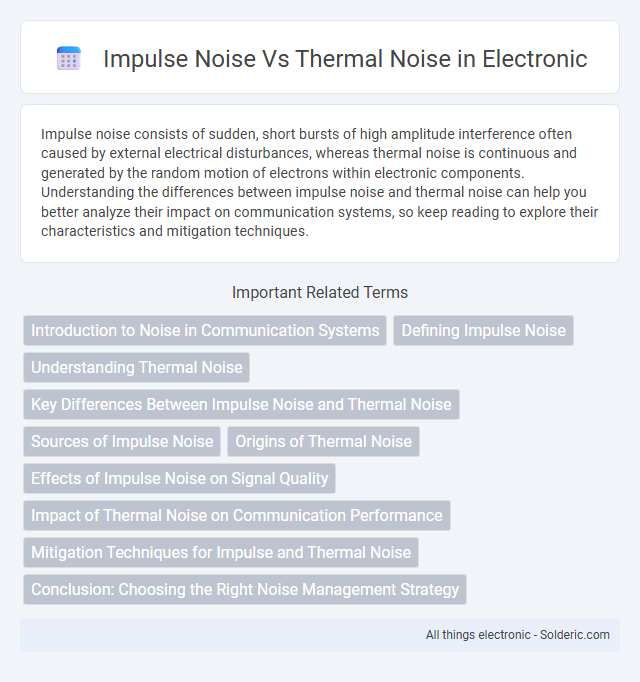Impulse noise consists of sudden, short bursts of high amplitude interference often caused by external electrical disturbances, whereas thermal noise is continuous and generated by the random motion of electrons within electronic components. Understanding the differences between impulse noise and thermal noise can help you better analyze their impact on communication systems, so keep reading to explore their characteristics and mitigation techniques.
Comparison Table
| Feature | Impulse Noise | Thermal Noise |
|---|---|---|
| Origin | Sudden, short-duration electrical disturbances | Random electron motion in conductors due to temperature |
| Duration | Short bursts, milliseconds | Continuous and constant |
| Source | Switching devices, lightning, electromagnetic interference | Resistors, transistors, all electronic components |
| Effect on Signal | Causes sudden spikes or pulses | Creates background noise floor |
| Spectrum | Broadband, non-Gaussian | White Gaussian noise |
| Amplitude | High amplitude spikes | Low amplitude, usually small variations |
| Mitigation Techniques | Shielding, filtering, error correction codes | Cooling, low-noise components, filtering |
Introduction to Noise in Communication Systems
Noise in communication systems includes impulse noise and thermal noise, each impacting signal quality differently. Impulse noise consists of sudden, short-duration disturbances caused by electrical switching or lightning, leading to bursts of errors in data transmission. Thermal noise, generated by the random motion of electrons in conductors, produces a continuous background hiss affecting the overall signal-to-noise ratio and your system's performance.
Defining Impulse Noise
Impulse noise is characterized by sudden, short-duration disturbances that cause significant spikes in a signal, often resulting from electrical switching or lightning strikes. Unlike thermal noise, which is continuous and caused by the random motion of electrons in a conductor, impulse noise appears as irregular bursts of high amplitude. This type of noise severely impacts communication systems by introducing transient errors and data corruption.
Understanding Thermal Noise
Thermal noise, also known as Johnson-Nyquist noise, arises from the random motion of electrons in a conductor due to temperature. It is present in all electronic devices and can degrade signal quality by introducing a constant background noise level, proportional to bandwidth and temperature. Understanding thermal noise helps you design systems with adequate signal-to-noise ratio for reliable communication and data transmission.
Key Differences Between Impulse Noise and Thermal Noise
Impulse noise consists of short-duration, high-amplitude spikes often caused by electrical switching or lightning, disrupting communication channels abruptly. Thermal noise, also known as Johnson-Nyquist noise, arises from the random motion of electrons in conductors, producing a continuous, low-amplitude background interference across all frequencies. Unlike impulse noise, thermal noise has a Gaussian distribution and is predictable based on temperature and resistance, whereas impulse noise is sporadic and unpredictable.
Sources of Impulse Noise
Impulse noise originates from sudden, short-duration disturbances such as electrical switches, lightning strikes, and electromagnetic interference from machinery, which cause abrupt spikes in signal amplitude. These noise spikes differ sharply from the continuous, random fluctuations typical of thermal noise generated by the thermal agitation of charge carriers in resistive materials. Impulse noise is characterized by its sporadic, high-intensity nature, often resulting in data corruption or signal distortion in communication systems.
Origins of Thermal Noise
Thermal noise, also known as Johnson-Nyquist noise, originates from the random motion of electrons in a conductor due to temperature. This noise is present in all electronic devices and circuits, caused by the thermal agitation of charge carriers within resistors and other components. Understanding thermal noise is crucial for optimizing the performance of your communication systems and minimizing signal degradation.
Effects of Impulse Noise on Signal Quality
Impulse noise causes sudden, short-duration disturbances that severely degrade signal quality by introducing high-amplitude spikes, leading to data corruption and bit errors in communication systems. Unlike thermal noise, which is continuous and Gaussian-distributed, impulse noise results in sporadic, unpredictable signal distortions that are more challenging to filter and mitigate. The presence of impulse noise reduces the signal-to-noise ratio (SNR) and can disrupt error detection and correction algorithms, significantly impacting overall system performance.
Impact of Thermal Noise on Communication Performance
Thermal noise, also known as Johnson-Nyquist noise, arises from the random motion of electrons in conductors and sets a fundamental noise floor in communication systems. It degrades signal-to-noise ratio (SNR), limiting data transmission rates and reducing bit error rate (BER) performance in wireless and wired channels. Unlike impulse noise, thermal noise is continuous and Gaussian-distributed, affecting all frequencies uniformly and challenging the design of sensitive receivers for optimal communication performance.
Mitigation Techniques for Impulse and Thermal Noise
Impulse noise, characterized by sudden, high-amplitude spikes, can be mitigated using techniques such as error correction coding, adaptive filtering, and impulse noise blanking, which effectively identify and remove transient disturbances. Thermal noise, a continuous and low-level background noise caused by electron agitation, is best reduced through cooling of components, using low-noise amplifiers, and optimizing circuit design to minimize resistance and bandwidth. Your communication system's performance improves significantly by tailoring noise reduction methods specifically to the distinct properties of impulse and thermal noise.
Conclusion: Choosing the Right Noise Management Strategy
Impulse noise consists of sudden, high-amplitude disturbances that can cause significant data errors, while thermal noise is a continuous, low-level background noise caused by the random motion of electrons. Your noise management strategy should prioritize impulse noise mitigation techniques like error correction and filtering in environments prone to transient spikes, whereas thermal noise is best addressed through hardware improvements and signal enhancement methods. Selecting the right approach depends on accurately characterizing the noise type and its impact on system performance.
Impulse noise vs thermal noise Infographic

 solderic.com
solderic.com